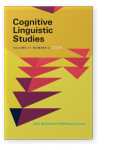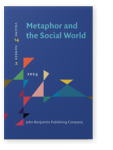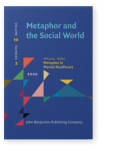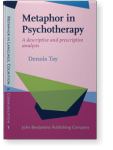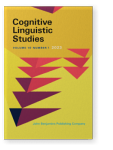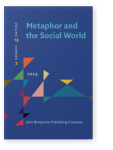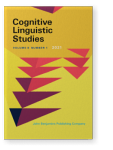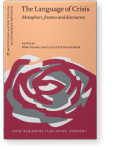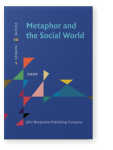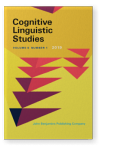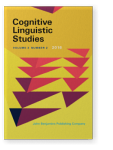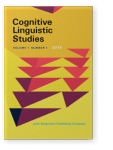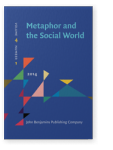Dennis Tay
List of John Benjamins publications for which Dennis Tay plays a role.
Journals
ISSN 2210-4070 | E-ISSN 2210-4097
Titles
Metaphor in Mental Healthcare
Edited by Dennis Tay
Special issue of Metaphor and the Social World 10:2 (2020) vi, 166 pp.
Subjects Cognition and language | Cognitive linguistics | Discourse studies
Metaphor in Psychotherapy: A descriptive and prescriptive analysis
Dennis Tay
[Metaphor in Language, Cognition, and Communication, 1] 2013. vii, 211 pp.
Subjects Cognition and language | Cognitive linguistics | Discourse studies | Pragmatics
2023 The image schemas of container and source-path-goal in the theory of psychodynamic defense mechanisms Cognitive Linguistic Studies 10:1, pp. 99–116 | Article
In this article, we evaluated the theory of defense mechanisms from the cognitive linguistics perspective. We chose two basic image schemas of container and path-goal and reviewed three psychodynamic psychotherapy textbooks and two psychology dictionaries to extract passages defining defense… read more
2023 Individual differences in identifying creative metaphors from video Ads Metaphor and the Social World 13:2, pp. 221–247 | Article
Reliable identification of metaphors from multimodal discourse has attracted scholarly attention in recent years. However, the role of individual differences in identifying creative metaphors from video ads is underexplored from an empirical perspective. This includes the extent to which… read more
2021 Discretion: The final particle ou and its functions in medical advice-giving Chinese Language and Discourse 12:2, pp. 158–180 | Article
This paper explores the functions of Chinese final particle ou in both TCU-final and non-TCU-final positions in medical advice-giving. Using Praat, we differentiated phonologically marked and unmarked ou and analyzed their functions in both doctor and patient speech. The findings suggest a… read more
2021 Making meaning with metaphor in grief therapy: A single-session segmental approach Cognitive Linguistic Studies 8:1, pp. 152–174 | Article
Metaphors play an important role in contemporary approaches to grief therapy by helping clients (re)construe their continuing relationship with the deceased. Relevant studies have illustrated the substantive elements of metaphors (i.e. sources, targets, and mappings) in this regard, often… read more
2020 Surveying views of metaphor vs. literal language in psychotherapy: A factor analysis Metaphor in Mental Healthcare, Tay, Dennis (ed.), pp. 273–291 | Article
Five key therapeutic functions of metaphors are often discussed by psychotherapists. They (i) help clients express emotions and experiences, (ii) help therapists and clients explain difficult concepts, (iii) introduce new frames of reference, (iv) help work through client resistance, and (v)… read more
2020 Chapter 8. Co-constructing ‘crisis’ with metaphor: A quantitative approach to metaphor use in psychotherapy talk The Language of Crisis: Metaphors, frames and discourses, Huang, Mimi and Lise-Lotte Holmgreen (eds.), pp. 231–254 | Chapter
Mental health professionals and their patients often use figurative language like metaphors to depict complex cognitions and emotions that lie at the heart of personal crises during psychotherapy. While qualitative analysis of these metaphors is crucial, understanding usage patterns that develop… read more
2020 Critical, conceptual, and collaborative perspectives on metaphor and mental health Metaphor in Mental Healthcare, Tay, Dennis (ed.), pp. 191–198 | Introduction
2020 A mixed-method analysis of image-schematic metaphors in describing anger, anxiety, and depression Metaphor in Mental Healthcare, Tay, Dennis (ed.), pp. 253–272 | Article
The importance of metaphor in psychotherapy and counseling has been shown by a growing number of studies. Image-schematic metaphors, which derive from experience of sensory processes and space, are potential resources for conceptualizing major themes like anger, anxiety, and depression in… read more
2020 A multifactorial analysis of metaphors in political discourse: Gendered influence in Hong Kong political speeches Metaphor and the Social World 10:1, pp. 141–168 | Article
The rising prominence of women in politics has sparked a growing interest in comparing the language of male and female politicians. Many researchers have explored whether gender in politics has had an impact on their metaphor styles. While these studies have been oriented qualitatively and have… read more
2019 Death in a multicultural society: Metaphor, language and religion in Singapore obituaries Cognitive Linguistic Studies 6:1, pp. 84–102 | Article
Obituaries are a tractable source of metaphorical depictions of death, which in turn offer unique insights into the near-universality versus culture and context-specificity of metaphors. In multicultural settings, they can shed further light on the underexplored question of how metaphor use… read more
2016 A variational approach to deliberate metaphors Cognitive Linguistic Studies 3:2, pp. 277–298 | Article
While Deliberate Metaphor Theory is controversial from a psychological point of view, its advocates propose that the communicative notion of ‘deliberateness’ is valuable for structural-functional analyses of metaphors in the social world. Nevertheless, the inter-relationships between the… read more
2015 Metaphor in case study articles on Chinese university counseling service websites Chinese Language and Discourse 6:1, pp. 28–56 | Article
This paper investigates metaphor use in case study articles (CSAs), which share knowledge and describe counseling processes, on a Chinese university counseling centre website. Metaphors from 27 CSAs were coded under the variables textual position, target, and source. Chi-squared tests of… read more
2014 Bodily experience as both source and target of meaning making: Implications from metaphors in psychotherapy for Posttraumatic Stress Disorder Cognitive Linguistic Studies 1:1, pp. 84–100 | Article
Bodily experiences (BE) are often theorized by cognitive linguists as sources of meaning making, encoded and projected at the levels of grammar, semantics, and discourse. For example, Conceptual Metaphor Theory regards embodied image schemas (Johnson 1987) and, more recently, live simulations of… read more
2014 At the heart of cognition, communication, and language: The value of psychotherapy to metaphor study Metaphor and the Social World 4:1, pp. 48–64 | Article
Cognitive, communicative, and linguistic forces have been theorized to inhere in all metaphor use in real world contexts, with Steen (2011) describing these forces as constitutive and interacting ‘dimensions’ of metaphor. This paper proposes that cognition, communication, and language should be… read more
